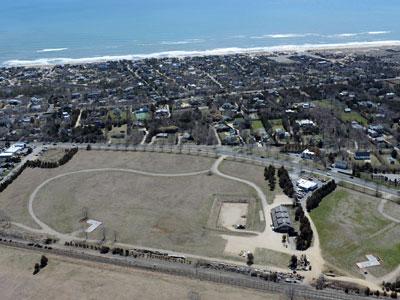The 411 on 555 Project

“Anything new on the 555 front?” East Hampton Town Councilwoman Sylvia Overby said she inquired casually on Monday afternoon as she passed Marguerite Wolffsohn’s office at Town Hall.
“As a matter of fact, there is,” replied Ms. Wolffsohn, the director of the town Planning Department, handing over a hot-off-the-printer copy of the initial site plan evaluation for the controversial Amagansett development. “And you’re the first to see it.”
Ms. Overby summed up the preliminary report a few hours later at the monthly meeting of the Amagansett Citizens Advisory Committee, most of whose members had listened in stony silence last month as the Connecticut developer of the proposed 89-unit complex on the former Principi property east of the hamlet ticked off its advantages, including a vast tax benefit for the town with no corresponding increase in school taxes. That, the developer, Francis Jenkins III of Putnam Bridge, said, was because the units — 23 apartments and 63 single-family residences — would be marketed to well-off baby boomers 55 and over, presumably empty-nesters, at market-rate prices presently set at $850,000 to $1.8 million.
Mr. Jenkins argued that East Hampton Town, with a growing population of older people, needs a community designed “with the active senior citizen in mind.” According to the preliminary plan submitted to the town planning board, 555 would include two tennis courts, two paddle tennis courts, a 12,000-square-foot pool house with two “fitness centers,” a common swimming pool, a groundskeeper’s residence, a greenhouse, a “field house,” and a “decorative windmill.”
But the site at 555 Montauk Highway is not presently zoned for senior housing, which, for its developers, is the largest of a number of stumbling blocks. Before its representatives could even begin discussions with the planning board, the town board would have to amend the town code. Or, as Councilwoman Overby put it Monday night, “If we don’t change the code, the whole thing is moot.”
The Planning Department’s advisory memo is intended, she explained, to “give the town board direction.”
Prepared by JoAnne Pahwul, the assistant planning director, it refers in considerable part to a report called “Senior Housing Needs in the Town of East Hampton,” which was written by a consultant to Putnam Bridge and submitted to planners in March along with the preliminary site plan. In 2012, that report states, the median age in the town was 43.8, with people 55 and over representing 32 percent of the population. Almost half of Amagansett — 46.2 percent — was over 55 last year, the report says, bolstering the developers’ case that more senior housing is needed there.
Ms. Pahwul, while acknowledging in her review that the statistics were “well documented,” pointed out that “the 2000 U.S. Census indicated that seasonal housing in Amagansett constituted 65 percent of all units.” She suggested that “the applicant should indicate what assurances can be given that this development would be supported by year-round residents,” and reinforced the point in noting the relatively high sales prices. “It is questionable as to how many of the town’s year-round senior residents could avail themselves of the proposed condominiums,” she wrote.
The developers’ report emphasized that 555 would be conveniently close to “health services, stores, public spaces, and transit hubs [the Amagansett train station],” but planners appeared unimpressed. “The project appears to be designed for an affluent population that is not known to support public transportation,” Ms. Pahwul wrote.
“They make a case for the fact that there’s an aging population, but not for the project,” she said by phone on Tuesday.
She concluded in her review that 555 “is not consistent with the scale and character of the community [. . .] does not meet zoning with respect to density, coverage, and setbacks [. . .] and “would eliminate scenic and rural vistas and result in the loss of 100 percent of the prime agricultural soils found on the parcel.”
Before Ms. Overby’s presentation, Sue Avedon addressed the Amagansett committee, suggesting that each hamlet send a representative to form a “citizens’ emergency response task force” that would help prepare for catastrophes on the order of Hurricane Sandy. For example, she said, they might map out the locations of generators all over town, so people would know where to find light, warmth, and communications. “The East Hampton Health Care Center [on Pantigo Road] has its own generator, but nobody knew and nobody came,” said Ms. Avedon.
“I think the town did as well as I expected,” said Kieran Brew, chairman of the advisory committee. “They blocked off the beach, cleared the roads, saved Montauk from being cut off. Have this conversation with the town board first.”
Michael Diesenhaus agreed. “Don’t form the committee first,” he said. “It sounds like an adversarial position. Address the emergency services people first. Not ‘You can do better,’ but ‘You did great, now how can we do better?’ ”
Ms. Avedon seemed amenable, saying she’d go first to the various advisory committees, whose town board liaisons could then bring the matter up before the board.
With Memorial Day rapidly approaching, the evening ended with a brief discussion of Indian Wells beach. The town’s new plan to control last summer’s rowdy crowds by limiting the weight and length of vehicles, restricting them to a maximum of eight passengers, posting no-parking signs on nearby side streets, and allowing only cars with resident stickers to pass a small “guardhouse” near Bluff Road to park or drop off passengers, will not be fully implemented until mid-June, said Councilwoman Overby, as code changes are necessary. The new restrictions would be enforced only on weekends and holidays, or on other peak days as determined by the police.
